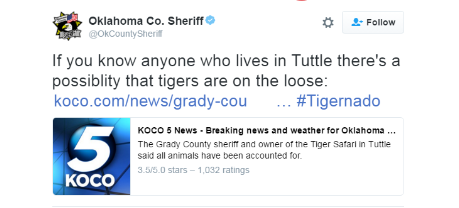A typical day interning at START consists of surfing Instagram, Facebook and Twitter. While doing this, I am occasionally asked by some of my fellow interns “What exactly does spending hours on social media have to do with terrorism research?” I pleasantly respond, “I’d be happy to tell you!”
On October 22, 2014, Michael Zehaf-Bibeau fatally shot Canadian solider Corporal Nathan Cirillo, in front of the Canadian National War Memorial in Ottawa, Canada. Zehaf-Bibeau then entered the Centre Block of the Parliament buildings where Members of Parliament, including Prime Minister Stephen Harper, were present.[1] During the crisis, social media played a vital role as an information channel. Local citizens were posting updates on the crisis on Twitter, and some posted photos showing the locations of where emergency responders were stationed. This prompted the Royal Canadian Mounted Police (RCMP)to ask individuals via social media not to post photos or information of where police officers were located.[2] The purpose of this was to protect the safety of the police officers, first responders and citizens in the area. Sergeant-at-Arms of the House of Commons, Kevin Vickers, later killed Zehaf-Bibeau in the House of Commons.[3]
Social media is a vital resource during crises for organizations who need to give the public quick and concise information during a crisis event. However, it also has the ability to be counterproductive. In the Ottawa crisis, it could have resulted in potentially harmful consequences. This is where individuals working in risk communication step in to understand the effects of social media during crises.

I was lucky enough to intern this past spring semester under Holly Roberts as part of the Risk Communication and Resilience team. One of the most interesting projects I worked on was examining how emergency responders and organizations communicate on social media during crises. We used the series of tornadoes that occurred in Oklahoma on May 6, 2015, as a case study. As various areas in Oklahoma were experiencing tornadoes, it was reported to local police that tigers were on the loose due to a local tiger safari in Tuttle, Oklahoma, being damaged by a tornado. This turned out to be a hoax. However, it resulted in a social media frenzy. The hashtag “#Tigernado” began trending on Twitter and Instagram for individuals to share information about this development. [4] As enjoyable as this project was to work on, particularly the laughs I experienced as I examined photo-shopped images of tigers in tornadoes, the case study provided compelling findings. It raised important questions about the presence and role of emergency responders and organizations on social media during crises.
Our examination found that only one emergency responders’ social media account engaged in the hashtag “#Tigernado” to provide information regarding the status of the tigers. In general, relevant parties failed to effectively dispel misinformation about the perceived crisis. This is problematic because social media has grown to be one of the most important ways individuals seek information during crises. Organizations have the ability to monitor social media platforms to correct misinformation during crises and share health and safety information with the general public; however, they forgo potentially life-saving opportunities when they misuse social media platforms.
As a graduate of the University of Toronto nearing the end of my Master’s program at the University of Waterloo, I have had an invaluable experience interning this past semester at START. I have been fortunate enough to spend these past several months in a new city contributing to meaningful research. The Risk Communication and Resilience team has allowed my fellow interns and me to work on a range of projects simultaneously, which has developed our skills and widened our knowledge for our future endeavors. Being an intern at START has also allowed me to build lasting friendships and expand my professional network. The diverse projects conducted at START demonstrate the value and importance of an interdisciplinary approach to terrorism research.
[1] http://www.cbc.ca/news/canada/ottawa/ottawa-shooting-one-year-later-1.3272984
[2] http://www.ottawapolice.ca/en/annual-report-2014/Power-of-social-media.asp
[3] http://www.cbc.ca/news/canada/ottawa/ottawa-shooting-one-year-later-1.3272984
[4] http://www.news9.com/story/29244529/animals-returned-to-tuttle-tiger-safari-park-following-tornado-damage
